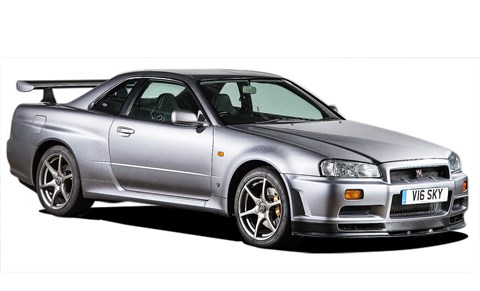► East vs West in an epic shootout
► NA V8 faces off against TT V6
► ‘This pony isn’t horsing around’
Eight-two-five-oh-emm-flippin’-gee… Harangue the Mustang’s rev counter needle to its 8250rpm limit and you feel like Columbus landing in America, Howard Carter opening Tutankhamun’s tomb or Buzz Aldrin following Armstrong onto the moon’s surface: you know men have been here before, but in your head none of them mattered.
The noise is intense, at low to medium revs rumbling with all the swagger of Link Wray’s seminal rock’n’roll riff, then segueing into a soaring shriek at the top end. It takes determination to get there. Rely on your ears alone, or your reading of the crude vibrations fed back through the seat, wheel and pedals, and you’ll both short-shift and short-change yourself. Keep it pinned, keep it coming, keep your eye on the tacho. And keep pinching yourself. This is a Mustang possessed. Little wonder the engine’s codename is Voodoo.
If the Mustang’s retro styling evokes memories, real or imagined, of a ‘better time’, so does the GT350’s V8. While all around car makers are switching to turbocharging, forgoing high revs and response for easy, clean power, Henry has blindsided everyone. Ford, the company that not too long ago was still peddling a supermini with a pushrod four, has built a sports car with a naturally aspirated flat-plane crank V8. Not even Ferrari makes one of those anymore.
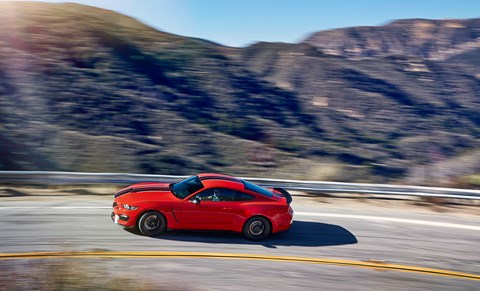
We hesitated before pitting this pair together. Incredible engine notwithstanding, can a $47,795 (£32,979) rear-wheel-drive Mustang really hope to compete with Godzilla, a state-of-the-art four-wheel-drive twin-turbo tech fest with nitrogen filled tyres and costing twice as much?
And besides, wind back the clock and this pair has something of a historical connection. Back in the ’60s the GT350 and GT-R were born with the same goal, but on different sides of the planet. That goal was to dominate national sports car racing in their respective countries. The Mustang came first, in 1965, a board-stiff stripped-out version of Ford’s smash-hit pony car. In his Venice workshop Carroll Shelby dropped in the 306bhp engine from his 289 Cobra, creating a podium-squatting regular, albeit one with the table manners of Lotto lout Michael Carroll.
By the decade’s end those bad manners had been tamed and then some, the GT350, by now overweight, air-conditioned, and often equipped with an automatic gearbox, usurped in the Mustang line-up in the eyes of the racing fraternity by Ford’s own high-revving in-house Boss 302 homologation special. But just as the 350’s sun was setting, thousands of miles across the Pacific in the land of the rising sun, its spiritual successor was making waves of its own.
The PGC10 Skyline wasn’t a clone of the GT350, and its 2.0-litre straight-six’s 160bhp meant it was half as powerful as the 4.7 Shelby. But the theme was similar: low weight, maximum focus. A prized race winner in its day, it’s a prized collector car in this one. As far as we know the original GT350 never faced down an original PGC10, so half a century later, we’re going to make amends.
The current Mustang range is the best yet, better built, better to drive and (contentious one, this) better to look at than any Mustang before it. And for the first time you can buy a European type-approved one through your Ford dealer that has a steering wheel on the right. But it won’t be a GT350. This is an altogether more serious Mustang and it’s only available on its home soil, which is why we’ve come to the spectacular San Gabriel mountains north of Los Angeles to find out what makes it tick.
Think of cars and LA and you’ll likely think of traffic gridlock, of smog and four-wheeled misery. Yet the city’s car fans are actually among the luckiest in the world. Less than an hour away, Alpine-like, pine-clad mountain passes, technical rock-lined switchbacks and fast, empty two-laners are there for the taking. And that’s where the GT350 is taking us.
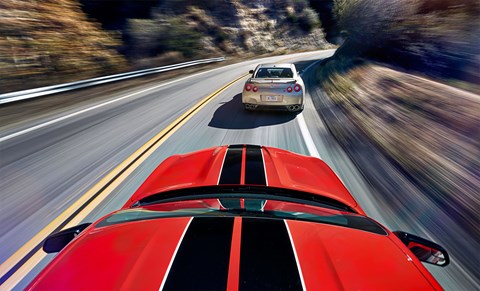
The GT350 is actually two distinct models, the cheapest of which costs less than a vanilla Euro-spec V8. For $11,400 over a 435bhp V8 ’Stang, the standard GT350 brings that trick V8 and 526bhp, 19in wheels, a six-speed manual ’box, a Torsen limited-slip diff and Recaro buckets. Throw in another $13,500 for the GT350R and you lose the rear seat, rear-view camera and floor mats, but gain MagneRide dampers, a strut brace, engine, transmission and differential oil coolers and genuine carbonfibre wheels that save 5.9kg per corner, but are painted black so no one knows but you and the shocks.
We’re in the far more practical base 350 today, so have to make do with boring old metal wheels. But ours does have the $6500 Track Pack, which adds most of the R’s other chassis and drivetrain goodies into the mix and arguably makes for the best 350 you can buy. Total price, including the optional racing stripes: $56,970, or £39,309 at current exchange rates. Preliminary verdict: bargain.
To keep things fair, and the Nissan’s price the sane side of six-figures, the Mustang’s foe today isn’t the crazy £125,000 Nismo GT-R, or even the mildly Nismo-tuned Track Pack car CJ enthused about recently, but which isn’t currently available in the US. Instead we’ve gone for the stock GT-R, albeit one dressed in last year’s limited edition 45th anniversary colours. That’s no longer available but fundamentally it’s the same as a stock GT-R, yours in the UK for £78,030.
It’s eight years since we first drove an R35 GT-R, long enough that we might get complacent about its abilities. Thankfully, Nissan certainly hasn’t, and has constantly upgraded its flagship with an Apple-like zeal to ensure it feels as stupendous as it did back in 2008, when in fact, with 543bhp to the original’s 478bhp, it’s on another level altogether.
Before those 20in wheels have made so much as a single rotation, the madness comes flooding back. And the crudity. For such a technically advanced machine, the GT-R can feel astonishingly agricultural. The rear-mounted seven-speed dual-clutch transmission clonks and bangs, and even at low speed the four-wheel-drive system with its unusual twin-propshaft arrangement whirrs and groans as if the car is supported by one solitary wheel and a stack of gyros to keep the thing aloft.
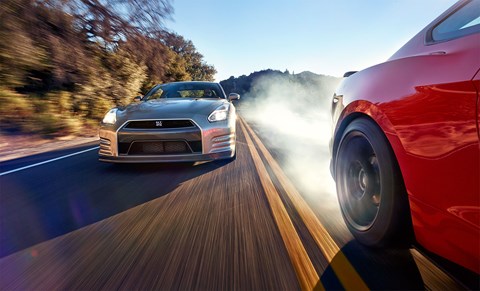
The disappointment lasts all of three seconds. By then you’ve got 60mph on the speedo and a GT350 plastered all over the rear-view mirror. Ford doesn’t quote performance figures for the GT350, but US magazine Car and Driver timed one at 4.3sec to 60mph (and 3.9sec for the R version) compared with 3.0sec dead for a current GT-R (Nissan claims 2.7sec).
How much of that gap is down to the Nissan’s four-wheel-drive advantage leaving the line? Some, but not as much as you’d think. A couple of roll-on drags along the lightly trafficked Glendale Freeway confirms a gut feel: the Ford talks a good game, but the GT-R, 17bhp and 37lb ft stronger, strolls past, shrugging off its 34kg weight disadvantage with the help of a dual-clutch ’box that shifts quicker than any human could swap gears in the manual Mustang. A muscle car outmuscled. Game over?
When we stop for breakfast at La Canada Flintridge, the gateway to the good stuff, the GT-R is sitting pretty, or as pretty as a car can when it’s dressed up like it’s off to bridge night at an old people’s home. Yes, the anniversary gold paint bestows a surprisingly demure, classy look to the GT-R, but we prefer our Godzillas to look scarier than a man in a rubber dinosaur suit.
We pick up the two-lane Route 2 and within a minute we’re scything through epic California canyon country. This is the Angeles Crest Highway. Big sweeping corners, dramatic views of LA, and at weekends, jammed with cars and bikes getting their rocks off rounding the rocks. But midweek it’s quiet and mostly cop-free, with just the odd Miata or sports bike flitting about. Easy meat for the GT-R.
Planted as a redwood and crushingly accelerative, the Nissan storms up the hills. It feels heavy because it is, but it also feels controlled, and you can’t help but be amazed that it can cover ground so fast, resist roll so well and grip until your arms are sore from the steering forces.
The only thing slow about it is the time it takes for a chink to appear in that armour. But eventually you discover a little understeer at the limit, and it doesn’t initially feel that adjustable. Turns out you’ve got to bully it, to push much harder to get beyond the point-and-squirt security. Then you can feel the torque being transferred to the rear axle to help. It sounds brutal, and can feel it. The real surprise and contradiction is how sensitive the steering is in this mix.
But for all its performance, the engine is actually rather dull. Whooorrsh, whooorrsh, whooorrsh it goes through the gears, thumping you firmly into the seat like a congratulatory slap on the back from the Hulk, but doing it with all the charm of the green guy’s grunts. Does that matter? I don’t know, or care to know how my Apple Mac gets these words on the screen, or the guy with inky fingers puts them on your page, as long as they appear.
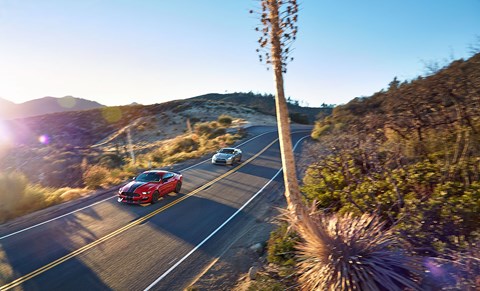
But engines are different. The Mustang’s certainly is, changing in feel and flavour repeatedly as the revs rise. True, there’s an overall refinement penalty resulting from that 180-degree crank layout, those last 1000rpm before the redline feeling far rougher than a high-revving cross-plane design such as the Audi RS4’s V8, but rewarding with faster pick-up through the range. It doesn’t exactly sound like a supercar either, but the noise it makes is exciting, and excited. It feels special, edgy and angry, and takes you on a journey through the rev range that’s every bit as varied as the one the tyres are arcing on the road.
The six-speed manual shift – there’s no automatic option, and you can forget about a dual-clutcher – only heightens the sense of involvement. It’s a Tremec, physically lighter than the standard GT’s Getrag transmission, a little notchy compared to a Corvette’s, but still satisfyingly positive. Of course an AI ’box could do it faster, but it wouldn’t be half as satisfying, a tenth as engaging.
Engagement. We’ve moved west to the sensational Little Tujunga Canyon Road. It’s tighter, narrower, trickier here. If you’re not engaged with the car, you could soon find a lack of engagement with the tarmac too. We’d tried to shoot on this stretch yesterday but abandoned the plan. Police cars, fire trucks and helicopters swarmed the place looking for a car that had supposedly disappeared over the side. Not exactly the right time for an 1100bhp face-off.
But the road’s clear now, the skies quiet. And the Mustang is a revelation. This is exactly where you’d expect a muscle car to fall apart, but, just like Shelby’s ’65 original, this isn’t a muscle car at all. There’s no hint of the standard Mustang GT’s slightly vague on-centre steering action, or – and show-offs might be disappointed here – its willingness to cremate its rear tyres on the exit of a corner like it’s warming the rubber in readiness to scream up the quarter mile. It’s a proper sports car, one that stops and steers and does it with clarity and finesse.
The steering’s ratio isn’t quick, but you twist the wheel and the chassis’ reaction is. The front-end stick is incredible. There’s less understeer than in the GT-R, better initial brake bite too, and when you lean on the rear tyres you rarely get more than the mildest shifts in attitude, enough to point the car, but never requiring more than winding off a little lock.
Get more ambitious, try to drive it like anything other than a true track car, say by trying for a lurid oversteer slide, and it remonstrates with a snap back into line. This is a serious machine. Forget your right-hand-drive 2.3 EcoBoost, a car supposedly engineered for Europe; in feel, this is the most European Mustang of all. Is it faster point-to-point than the GT-R? Probably not. Is it more satisfying? Undoubtedly.
The Mustang is also slightly roomier than the GT-R, has a better driving position, suffers less tyre noise at a cruise and has a boot that doesn’t require a crane to load with luggage. But it’s also fractionally thirstier, has a messier dashboard design, and while it might feel sticky here on hot Californian bitumen, throw some rain into the mix and the rear-drive Mustang is suddenly going to feel a whole lot less tidy.
It’s also not a GT-R, and for guys who’ve grown up enthralled by Japanese car culture, that’s an insurmountable hurdle. The GT-R remains a special thing, not the ultimate version of something less important, but its own entity. Culturally, as much as dynamically, it’s a monster. You have always felt, and will always feel, invincible in a GT-R.
But maybe you shouldn’t. The GT-R is far from the blunt instrument it’s sometimes accused of being. It’s aggressive, incisive and devastatingly fast, and it only gets more entertaining the more speed you pile on. But the Mustang’s a more organic machine, more tactile, more agile, and it’s all those things whether you’re going fast or slow. In the US it’s also half the price of the Nissan, a car whose cost has crept up steadily over the years, but still delivers an incredible bang per buck.
If my postcode was a zip code my GT would be a 350 not an R. Clobbered by import tax and VAT that’d likely take its price to £60k as a personal import and hampered by a steering wheel on the wrong side, a grey-import GT350 in the UK wouldn’t look quite so appealing. We’d steer you Nissan’s way. But we’d recommend you give the Mustang serious consideration. This pony isn’t horsing around.
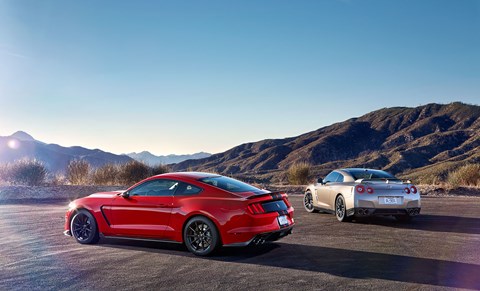
The specs: Ford Mustang Shelby GT350
Price: $47,795 (£33,503 at current rates)
On sale: Now (personal import in UK)
Engine: 5163cc 32v V8, 526bhp @ 7500rpm, 429lb ft @ 4750rpm
Transmission: Six-speed manual, rear-wheel drive
Suspension: MacPherson strut front, multi-link rear
Performance: 4.5sec 0-62mph, 190mph, 20mpg, 300g/km CO2 (est)
Length/width/height: 4798/1928/1377mm
Weight: 1706kg
Rating: *****
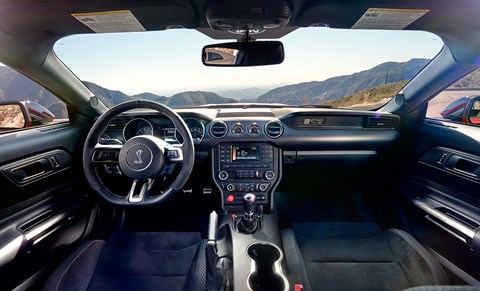
The specs: Nissan GT-R
Price: £78,030
On sale: Now
Engine: 3799cc 24v V6, 543bhp @ 6400rpm, 466lb ft @ 3200rpm
Transmission: Six-speed dual-clutch, four-wheel drive
Suspension: Double wishbone front, multi-link rear
Performance: 2.7sec 0-62mph, 196mph, 23.9mpg, 275g/km CO2
Length/width/height: 4670/1895/1370mm
Weight: 1740kg
Rating: ****

Shelby Mustang GT350 vs Nissan GT-R: a tale of two bloodlines
1965 Shelby GT350, 4.7 V8, 306bhp – The 2.7 RS of the classic Mustang world. A circuit weapon – and available to rent through a certifiably nuts Hertz
1967 Shelby GT350, 4.7 V8, 306bhp – Sharkier styling, but new 7-litre GT500 was top dog and GT350 withered to a venom-free 250bhp for ’68
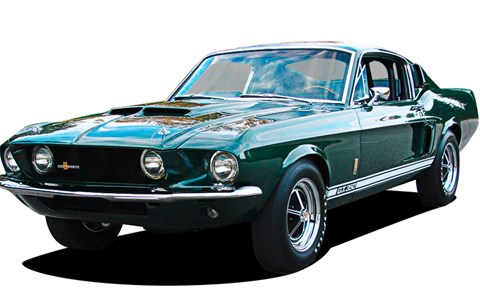
1969 Shelby GT350, 5.8 V8, 250bhp – By now a Ford-built boulevardier with little Shelby content. Car and Driver called it ‘a garter snake in Cobra skin’
2007 Shelby GT, 4.6 V8, 319bhp – Customer version of ’06’s black and gold GT-H Hertz rental. Little faster than stock and suspension stiffer than a week-old baguette
2011 GT350, 5.0 V8, 525bhp – Rapid Shelby-built special featured optional supercharged V8 capable of a GT500-beating 3.7sec to 60mph
1969 PGC10 Skyline GT-R, 2.0 4-cyl, 160bhp – Looked like a Lada, went like a MiG. Four-door saloon came first; shorter, lighter KPGC10 coupe arrived in ’71
1972 KPGC110 Skyline GT-R, 2.0 4-cyl, 160bhp – Short-lived gen 2, or ‘Kenmeri’, featured same triple Weber six, but with discs all round. Killed by new emissions regs
1989 BNR32 GT-R, 2.6 6-cyl, 276bhp – After 16 years away the GT-R was back, this time as a turbo’d 4wd. Dominated Group A racing; gained Godzilla tag
1995 BCNR33 GT-R, 2.6 6-cyl, 276bhp – Longer and heavier, and supposedly making the same 276bhp, but more durable and featuring an active limited-slip diff
1999 R34 GT-R, 2.6 6-cyl, 276bhp – Shorter overhangs and a dashboard with fancier graphics than the PlayStation most know it from. Last of the Skyline GT-Rs
